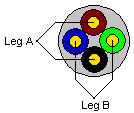|
Those who wish to improve their Hi-Fi output may well be interested in this article. When feeding speakers some distance from the power amplifier the secret in ensuring most of the power is not lost in the cable is to keep its impedance as low as possible. Hi-Fi enthusiasts (so-called) will claim that "monster" cable is the best available. Even the manufacturers will have you believe it is also 'non inductive'. I don't want to go too far down that route except to invite you to do a little research into how can a piece of wire be made 'non inductive', while keeping the resistance low. When you come up with the same answer as I did being you cannot, you'll realise that many have been conned into paying exorbitant prices for a simple fact being surface area. The combination of surface and cross-sectional area is what makes a good speaker cable. A popular long distance speaker cable is standard 3-core flexible mains cable. The popular method is to common up the Earth (green-yellow) and Neutral (blue) as one leg and the Live (brown) as the other. Although nothing is inherently wrong with this thinking, there is a better way of doing things. The main idea is to have the maximum amount of cross-sectional area for low frequency conduction, while having a large surface area for the high frequency conduction (because of 'skin effect'). All this to be accomplished without making the cable too large. Let us take 40 metres of 3-core mains cable of 1.5mm2. The one leg will obviously be 3mm2 (with two conductors parallel). The loop resistance is only 1.5 times the conductor resistance. Each conductor is 0.5Ω so the total resistance would be 0.75Ω (remember, the one leg is doubled so the resistance is halved). The surface area per conductor is 4.3mm. Although the double conductor leg will have 8.6mm surface area, the maximum available surface area is that of the single conductor leg, this being 4.3mm.
But the surface area becomes astonishing. For 1mm2 cable the surface area is 3.5mm per conductor, or 7mm per leg. That is over 1.5 times the 3-core cable. Furthermore, the frequency limit (skin effect) of 1.5mm2 is just under 10kHz. 1mm2 cable is capable of working to short of 14kHz. Quite a significant difference - and those who believe skin-effect isn't an issue at audio frequencies, well..... The only factor to remember is to use the opposite conductors as pairs (as shown). This is done to minimise the inductance of the cable as a whole (each leg is cancelled by the others). Should you need more cross-section then use 6 or 8 core 1mm2 cable. A word about 1/4" phone 'jack' plugs - Yuk!:
One thing even right angle 1/4" plugs cannot avoid and that is if they slide out a small way they are prone to short, and that means the output of the amp! My preference is the XLR range. In Closing:
© 09.09.01 / 09.06.06 |
 Using a 4-core cable, even one size smaller and therefore cheaper, can offer significant advantages. Take a 1mm2 cable, each leg being a pair of conductors. Each conductor is 1.5 times in resistance of a 1.5mm2 cable, but when paralleled becomes 0.375Ω (we assume the same length as our previous example). The total loop resistance has therefore remained at 0.75Ω.
Using a 4-core cable, even one size smaller and therefore cheaper, can offer significant advantages. Take a 1mm2 cable, each leg being a pair of conductors. Each conductor is 1.5 times in resistance of a 1.5mm2 cable, but when paralleled becomes 0.375Ω (we assume the same length as our previous example). The total loop resistance has therefore remained at 0.75Ω. When personally forced to use such plugs the preference is right-angle types. The leverage on the point where the 'sleeve' contact joins the plug body is drastically reduced and becomes more of a "shearing action" rather than a "bending" one. With right-angle types there is also a means (usually) to solder the cable directly to the sleeve contact as it comes through the casing (all-metal types are best as the sleeve can be soldered to the body too for even more strength).
When personally forced to use such plugs the preference is right-angle types. The leverage on the point where the 'sleeve' contact joins the plug body is drastically reduced and becomes more of a "shearing action" rather than a "bending" one. With right-angle types there is also a means (usually) to solder the cable directly to the sleeve contact as it comes through the casing (all-metal types are best as the sleeve can be soldered to the body too for even more strength).